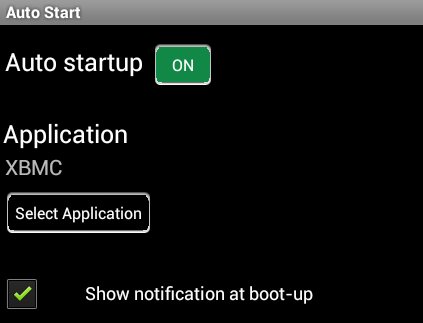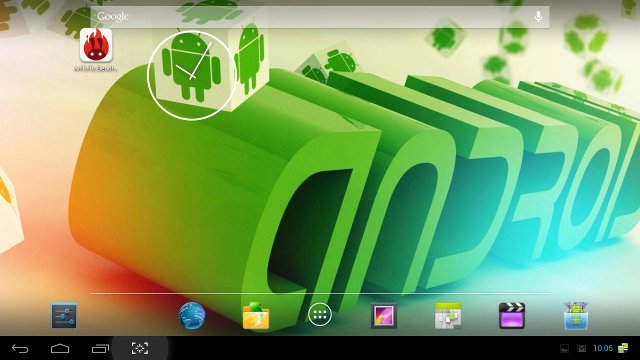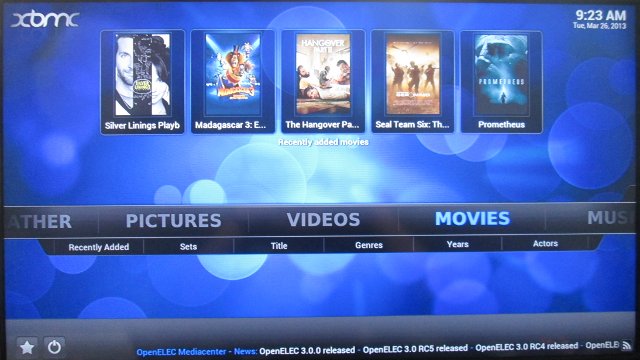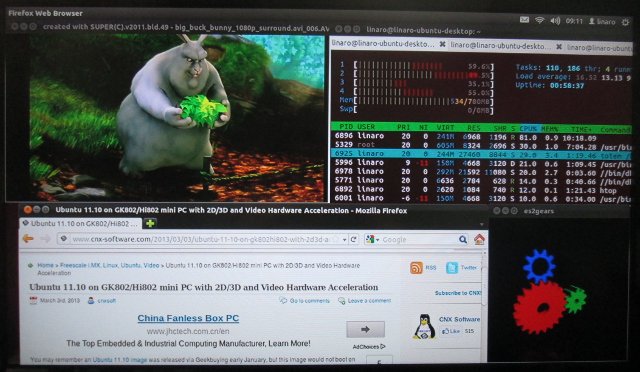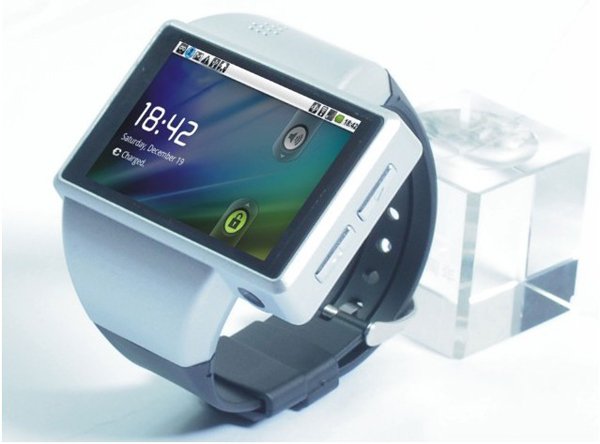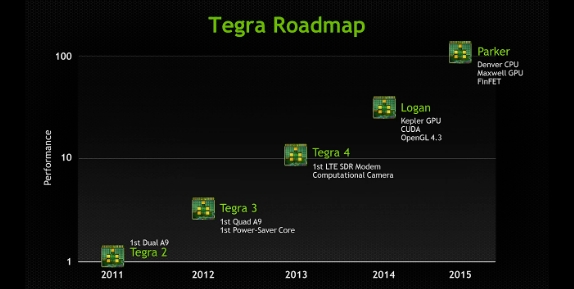Android is great thanks to its versatility and the ability to install the apps you need. However, if you have an Android set-top box or mini PC connected to your TV, you may just want to use it as a media player running XBMC, and clicking on the XBMC icon each time you start your device is not ideal. Luckily, there’s an easy solution to autostart XBMC or any application in Android: Install AutoStart – No root in your Android device. Run the application and select XBMC as shown below. There’s no need to tick “Show notification at boot-up”, since XBMC will just show in the foreground. Done! Next time you restart your device XBMC will run automatically. I’ve tried it in Tronsmart Prometheus, and it boots to XBMC within 50 seconds. If you want to use another app in Android, simply exit XBMC. Jean-Luc Aufranc (CNXSoft)Jean-Luc started CNX Software […]
Updated Review of Tronsmart Prometheus with Android 4.2 and XBMC
Earlier this month, a new firmware for Tronsmart Prometheus with Android 4.2 and XBMC with hardware acceleration has been released. Several users left divergent opinions about this firmware, so I’ve decided to give it a try, and write an updated review of Tronsmart Prometheus. I’ll focus on the new features and performance of Android 4.2, XBMC video testing, and see if some of the bugs I found in my earlier review have been fixed. Android 4.2 Features and Benchmarks The firmware file and instructions are available on Tronsmart website. The procedure is straight forward so I won’t repeat it here. During the first boot after the upgrade, you’ll be taken through a wizard to configure your device (e.g. Ethernet, WiFi,…). The first think you’ll notice is a slightly different Home Screen in Android 4.2. There are several small UI improvements / modifications, but the most interesting features for me in […]
OpenELEC 3.0.0 on Raspberry Pi – Installation and Video Tests
Yesterday, OpenELEC developers announced the release of OpenELEC 3.0.0, a lightweight OS running XBMC Frodo 12.1 for several platforms including the Raspberry Pi (OpenELEC stands for Open Embedded Linux Entertainment Center). When the Raspberry Pi was initially released, I did not feel like testing it as a media center, mainly because of codecs limitations. But over time, this has improved with the availability of MPEG-2 and VC-1 codecs (for a fee), and GPU accelerated support for free codecs such as VP6 and VP8, so today I’ve tested to give a try and install OpenELEC 3.0.0 on my Raspberry Pi. I’ll first give installation instructions, then test several types of videos container formats, and video / audio codecs, as well as give some quick impression about the performance and stability of OpenELEC on this low cost board. Installing OpenELEC on Raspberry Pi To install OpenELEC, I basically followed the instructions provided […]
Ubuntu 11.10 Image for Hi802 / GK802 is Now Available for Download
About 2 weeks ago, Jasbir released an Ubuntu 11.10 image and installation instructions for GK802 and Hi802 mini PCs based on Freescale i.MX6. I could only find time to give it try yesterday and today. I’ll provide the steps I followed to install the image, and my quick first impressions of the stability and performance of this image. Installation Instructions I mainly followed the instructions provided by Jasbir, and run GParted to increased the partition size on my micro SD card. The image is for a 8 GB micro SD, but those instructions should work on 4GB SD card and greater, as the rootfs partition is only 3GB large. Download the Ubuntu 11.10 image, uboot, as well as the kernel image and modules in a Linux PC:
|
1 2 3 4 |
wget http://dl.miniand.com/jas-hacks/gk802/ubuntu_gk802.img.gz wget http://dl.miniand.com/jas-hacks/gk802/u-boot.imx wget http://dl.miniand.com/jas-hacks/gk802/uImage_3.0.35-0269_cpu_freq wget http://dl.miniand.com/jas-hacks/gk802/modules_3.0.35-02695.tar |
Copy the image, uboot and the kernel to the micro SD card by typing the commands below:
|
1 2 3 4 |
gzip -d ubuntu_gk802.img.gz sudo dd if=ubuntu_gk802.img of=/dev/<sd_device> sudo dd if=u-boot.imx bs=1k seek=1 of=/dev/<sd_device> && sync sudo dd if=uImage_3.0.35-0269_cpu_freq of=/dev/<sd_drive> bs=1048576 seek=1 && sudo sync |
Replace /dev/<sd_device> by your […]
Z1 Android 2.2 Smart Watch Phone
There’s currently a lot of articles about Apple, Samsung, and Google smart watches rumors in the blogosphere. I’ve written about other smartwatches in the past with products such as the Pebble or Wime Nanowatch, but those are based on low-end hardware that do not run Android directly, but instead communicate with your Android or iOS device via Bluetooth. The only watch I know that runs (a customized version of) Android is the “I’m Watch“. You’ll need relatively deep pockets to purchase it as price starts at 249 Euros / $349 US and goes up to $19,999 if you purchase the version with white gold and diamonds. So I decided to have a look if there are lower cost Chinese Android smartwatches around. The Z1 Android Smart Watch Phone showed up everywhere in my searches. The product is not new, as Charbax first discovered it in January 2012 and it was […]
Nvidia Updates its Tegra Roadmap with Parker 64-Bit ARM SoC, Unveils Kayla CUDA Development Platform
Nvidia has given an update about the roadmap for its Tegra processor at the GPU Technology Conference in San Jose, California. Tegra 4 will still be followed by Logan (Tegra 5) as planned with a Kepler GPU and support for CUDA and OpenGL 4.3, but “Stark” has been replaced by “Parker” (Tegra 6) which will be the first 64-Bit Tegra processor based on Denver CPU, Maxwell GPU and make use of Finfet transistors. Logan will be available in 2014, and Parker should be available in 2015 with 100 times more performance than Tegra 2. With this kind of performance, the separation line between desktop and mobile processors will be gone. Nvidia also unveiled Kayla (“Logan’s girlfriend”), a development platform for CUDA and OpenGL based on Tegra 3 quad-core ARM processor and a Kepler GPU connected via a PCI express slot. Jen-Hsun Huang (above) showcased Kayla performance by running real-time ray […]
$19 RFDuino is a Coin-sized Bluetooth Arduino-compatible Board
RFDuino is a tiny board, about the size of a coin, powered by Nordic nRF51822 Cortex M0 SoC including bluetooth 4.0 LE support, and software compatible with Arduino UNO and DUE board, so you can just use Arduino sketches with the board. Bluetooth allows it to communicate with your smartphone (iPhone for now, but Android support is coming) to control motors & relays, monitor sensors, turn LEDs on/off, and more. Key features of RFDuino board: MCU – Nordic nRF51822 Cortex M0 @ 16 MHz Memory – 16 KB on-chip SRAM Storage – 256 KB on-chip Flash Connectivity – Bluetooth 4.0 Low Energy built in MCU GPIO – 7 pin software configurable as digital IO, analog ADC, SPI, I2C, UART and PWM. The company currently offers several stackable shields for RFDuino including battery shields (1x AAA, 2x AAA, and CR2032 coin battery), a servo shield, a USB shield, a prototype shield […]
Ittiam HEVC Decoder To Provide H.265 Video Decoding for Existing ARM Cortex-A Devices
H.264 is now the favorite codec for many applications, and all ARM SoC providing multimedia capabilities support it. However, a new codec called H.265 (aka HEVC) is coming with twice the compression ratio with the same quality saving a lot of money for those who have to pay for the bandwidth. The transition between video codecs is normally a slow process, but as it happens you may wonder if you’ll be able to play H.265 videos on your existing ARM Cortex A9/A15 devices which do not support H.265 hardware video decoding. The answer appears to be “Yes You Can!”, as Ittiam Systems announced an HEVC decoder specifically designed for ARM Cortex A processors. More specifically their software decoder will support: ARMv7 Cores with NEON – Cortex A8, Cortex A5, Cortex A9, Cortex A15, Cortex A7 and the multi core variants Qualcomm Snapdragon APQ8064/MPQ8064 , MSM8960 Ittiam HEVC decoder mainly targets devices such […]


